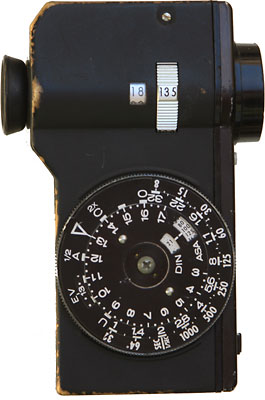
|
  Maker: Sekonic Model: L-228 "Zoom-Meter" Circa: 1970 - 1979 Price (new): $69.95 Cell type: CdS Measure type: Spot Battery (orig): Two 1.35V Mercury (H-R) Battery (replacement): n/a |
|
First off, it's got more metal and less plastic. That adds weight but it feels more substantial and trustworthy. Second is that the meter-scale is read inside the finder, rather than on the outside. The View Meter uses a pointer-lock to hold the exposure while you take your eyes off the finder, but I still think this is a better deal, especially if you want to meter different areas and see the difference. Then there's the variable zoom. While the View-Meter is locked in at a 10° angle, this one varies between 28° and 8.2°. The zoom knob on the side is calibrated both for the degree coverage and the 35mm (full-frame) equivalent lens length. That's useful if you've got a particular telephoto lens (between 85mm and 300mm) and you want a full-frame "average" for that length. The last nifty feature is the Weston-style calculator dial, complete with our old friends, the UAOC marks. If you're familiar with Weston Masters, you know what they're for. I wonder if this was originally meant to be the successor to the Weston Ranger 9. The calculator dial is nearly worth the price of the meter by itself. Besides the UAOC, it's big and easy to read. ƒ/stops are marked in ½-stops, everything else is in 1/3rd stop increments. It has ASA and DIN markings, an EV dial, and about 7-stops of coverage on the outer dial in case you want to print-out a little zone-system scale to tuck-in (if you figure that the usuable range is Zones II through IX, a 7-stop scale is sufficent). It's also smooth turning yet easy to set. I'm tempted to take the calculator dial off and throw it in my camera bag as a separate accessory. Now the bad news: it's a CdS meter from the mercury-battery era, so you have to figure out how to compensate for modern batteries with higher voltage. Personally, I think this would be a great candidate for the Schottke Diode conversion. |
|
©opyright by James Ollinger. All Rights Reserved.
Company names and models are registered trademarks of their respective owners
and are not affiliated with this website in any way.

-s.jpg)